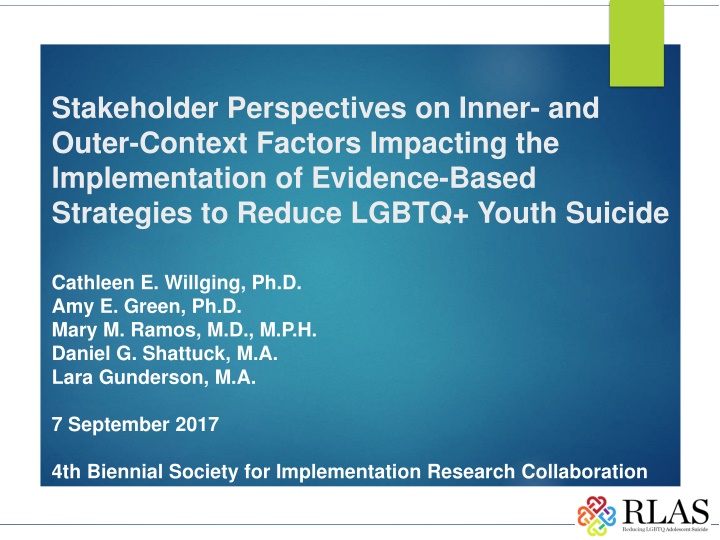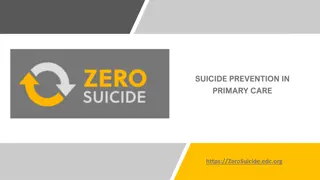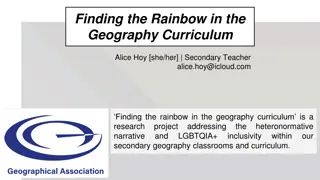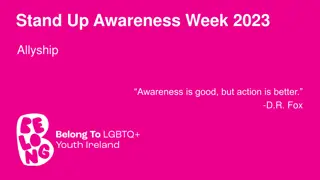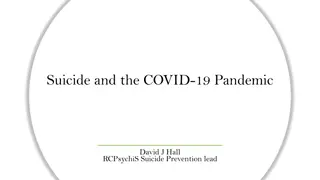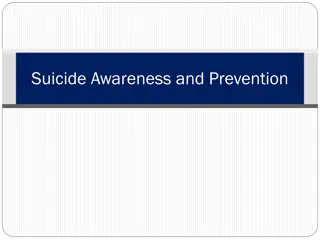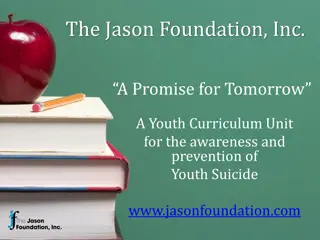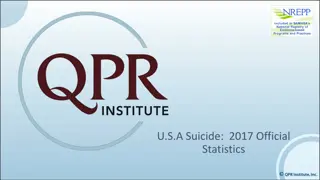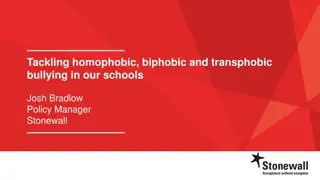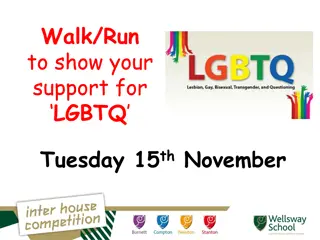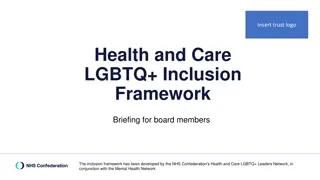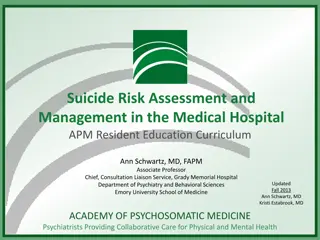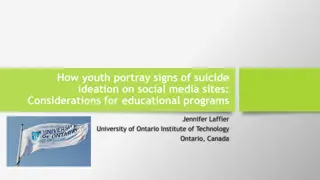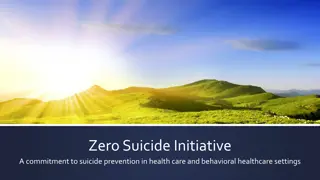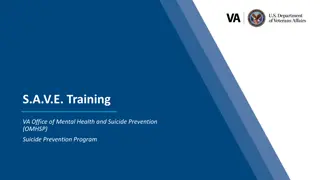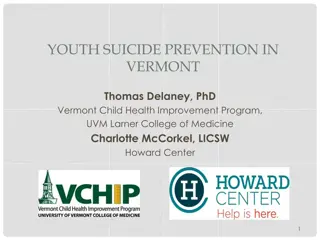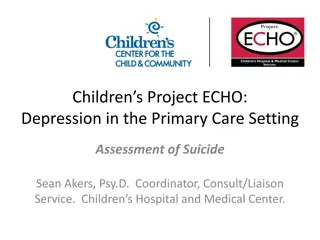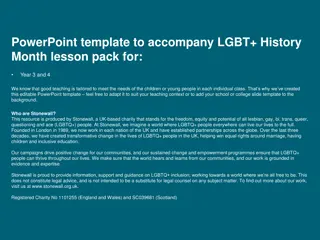Stakeholder Perspectives on Factors Impacting LGBTQ+ Youth Suicide
This research explores stakeholder perspectives on inner and outer context factors influencing the implementation of evidence-based strategies to reduce LGBTQ+ youth suicide. It delves into disparities in bullying, substance use, sadness, and suicide behavior among sexual minority and straight youth. The study emphasizes the importance of school settings in addressing mental health concerns and highlights evidence-based strategies recommended by the CDC.
Download Presentation

Please find below an Image/Link to download the presentation.
The content on the website is provided AS IS for your information and personal use only. It may not be sold, licensed, or shared on other websites without obtaining consent from the author.If you encounter any issues during the download, it is possible that the publisher has removed the file from their server.
You are allowed to download the files provided on this website for personal or commercial use, subject to the condition that they are used lawfully. All files are the property of their respective owners.
The content on the website is provided AS IS for your information and personal use only. It may not be sold, licensed, or shared on other websites without obtaining consent from the author.
E N D
Presentation Transcript
Stakeholder Perspectives on Inner- and Outer-Context Factors Impacting the Implementation of Evidence-Based Strategies to Reduce LGBTQ+ Youth Suicide Cathleen E. Willging, Ph.D. Amy E. Green, Ph.D. Mary M. Ramos, M.D., M.P.H. Daniel G. Shattuck, M.A. Lara Gunderson, M.A. 7 September 2017 4th Biennial Society for Implementation Research Collaboration
Acknowledgements and Partners LGBTQ+ refers to lesbian, gay, bisexual, transgender, queer, questioning, and other variations of sexual and gender identity This work is funded by the Eunice Kennedy Shriver National Institute of Child Health and Human Development (1R01HD83399) No Conflicts of Interest to report
Bullying Disparities Electronically Bullied Bullied on School Property Missed School Past 30 days 32.1% SM 27.2% SM 16% sexual minority (SM) 6.1% straight 16.1% straight 11.2% straight CDC, 2015 YRBSS, New Mexico Data
Substance Use Disparities Prescription Drugs (without prescription) Ever use Alcohol Currently drink Marijuana Currently use 40.9% SM 33% SM 41.9% SM 24% straight 22.7% straight 11.3% straight CDC, 2015 YRBSS, New Mexico Data
Sadness and Suicide Behavior Disparities (Past Year) Attempted Suicide With Injury Attempted Suicide Felt Sad/ Depressed 60.1% SM 11.2% SM 29.1% SM 28.4% straight 6.6% straight 2% straight CDC, 2015 YRBSS, New Mexico Data
Why are School Settings Important? Kids spend most awake hours at school, not at home Schools part of de facto behavioral health infrastructure Lack of adolescent behavioral health services and resources Comprised of school nurses, counselors, social workers, etc. Responsible for early identification, referrals, and policies School connectedness second in importance in protecting against suicidal behavior!!! Family connectedness is first
Six Evidence-Based Strategies Recommended by Centers for Disease Control and Prevention (CDC) Evidence-Based Strategy U.S. Median (Range) 1. Identify/access safe spaces on campus. 2. Prohibit harassment and bullying based on sexual orientation or gender expression. 61.4% (36.8-84.7) 89.4% (72.9-97.1) 3. Facilitate access to medical providers with experience providing services to LGBTQ+ youth. 4. Facilitate access to behavioral health providers with experience providing services to LGBTQ+ youth. 5. Encourage professional development on safe and supportive school environments. 6. Provide health education curricula with information relevant to LGBTQ+ youth. Implement all six strategies. 46.3% (29.7-69.0) 49.2% (30.0-72.9) 59.0% (38.9-82.4) 24.4% (11.0-56.4) 7.6% (2.1-27.2) CDC, 2014
The RLAS (Reducing LGBTQ+ Adolescent Suicide Intervention) Study Uses the Dynamic Adaptation Process (DAP) and engages school nurses and other health professionals as leaders in the scale up of the six CDC- recommended evidence-based strategies To improve school climate for LGBTQ+ youth To reduce depression, substance use, and suicide risk among LGBTQ+ youth and their peers in high schools
Key Design Features of RLAS Delayed intervention design 20 schools randomly assigned to implement RLAS (experimental condition/DAP-enabled) 20 schools will continue with usual care (control condition; no DAP) Mixed-method evaluation approaches Annual qualitative and quantitative interviews and surveys Stages of Implementation Completion Quantitative data from the bi-annual New Mexico-Youth Risk Behavior Surveillance System (YRBSS)
Dynamic Adaptation Process Exploration Preparation Sustainment Implementation School-Level Assessment Leadership Support Organizational Culture/Climate Resources/Readiness Implementation Resource Team School Nurses Counselors Social Workers Health Educators LGBTQ+ Youth Academic Researchers Nurse-Level Assessment: Demographics Work Attitudes Attitudes towards Evidence-Based Strategies Outcomes Strategy Adherence Strategy Utilization Nurse Satisfaction IRT Member Satisfaction Evidence-Based Strategy Training Training/TA with context- driven adaptation support Student-Level Assessment Race/Ethnicity/Culture Socioeconomic Status Behavioral Health Needs Ad Hoc Adaptations Student emergent issues Nurse skills and abilities Available resources Service context adaptation Ongoing Feedback
Participants 96 Implementation Readiness Interviews 55 Implementation Resource Team (IRT) Leads and Co-Leads 41 Administrators Demographics Average 47 years old 7 years at in their schools 2/3 Female, 1/3 Male, 1 Transgender woman White (81%), Native American (9%), Black (3%) Hispanic/Latino ethnicity (44%)
Methods Open-ended queries addressing system, nurse/health professional, and student levels, and focusing on: Attitudes, school policies and practices, organizational issues Use of NVivo 11 for iterative coding and thematic analysis Findings organized into outer and inner context Outer-context factors = broader environments of schools and their staff (e.g., policies, funding, and community influences) Inner-context factors = internal operations of schools (e.g., organizational characteristics and staff attitudes and behaviors)
Key Findings Outer Context Inner Context Socially-conservative community orientations Staff knowledge of and exposure to LGBTQ+ issues Current political climate Training deficits Community resources Health education curricula District/school policies Neutrality discourses De facto safe spaces Student attitudes and support Pragmatic considerations
Exploration Phase OUTER CONTEXT THEMES
Socially-Conservative Community Orientation Perception that the surrounding community lacks understanding of what it means to be LGBTQ+ There's a lot of our community that still feels like you can just learn how to be a different way because they just don't understand. That's what we've got going on in our community . Until you've had that experience where someone close to you has gone through it, it's hard for you to understand. (School Nurse)
Current Political Climate Fear of influence of hostile political ideologies The only thing that I have seen or felt recently is just the political climate of the nation that's trickling down. I do feel like New Mexico is probably a pretty safe state but I have felt and seen some changes that aren't so positive. Just some heaviness where people were feeling a little bit more confident to go forward, I think they're retreating back into their isolations. That hurts my heart. (Principal)
Current Political Climate (cont.) LGBTQ+ rights as major civil rights struggle of our day Legally there has to be some kind of protection. There has to be a way of ensuring that this is a recognized legal issue process that protects transgender, LGBTQ people, equally as others because of the fact that there is such a frustration right now because of the politics that we have seen develop this last election cycle. It has brought to the forefront this kind of an issue in a very negative way . Potentially, legally and otherwise, we need to ensure that we create environments that will permit students to be comfortable in their skins. (Principal)
Community Resources Outside of metropolitan areas, very little choice regarding medical and/or behavioral health providers Participants expect local providers to be affirming of LGBTQ+ folks, but are unsure whether this is the case No or little awareness of local or statewide LGBTQ+ resources I have no knowledge on that. (Principal)
District/School Policies Participants (including principals) often think policies are inclusive of LGBTQ+ students, but can rarely say for sure Policy concerns related to transgender students are of paramount concern
District/School Policies (cont.) We do not have a genderless bathroom. For some of our kids changing for PE [physical education] because they don t have locker rooms or just even going to the bathroom throughout the day, we want to make sure that they have a place where they feel safe and we re working on how could we meet with the facilities committee and see if we can get one of the bathrooms to be ungendered. (School Nurse)
(Lack of) Parent Support Parental concern regarding LGBTQ+ inclusion Schools as an escape from a potentially unwelcoming family and community Parents here are very, very old school . A lot of the kids here identify at school but not at home (School Nurse)
Exploration Phase INNER CONTEXT THEMES
Staff Knowledge and Exposure Staff perceived as best qualified often lack education on LGBTQ+ issues You had five professionals in the room this morning and two had to get clarification before you had come and definitions and the other three had no exposure and those are the people that we ve identified as probably the best to support these children so just that lack of understanding and local knowledge. (School Nurse) Or knowledge is perceived to be limited to one or a few staff people often the LGTBQ+ identified staff Discomfort with vocabulary
Training Deficits Few schools provide regular schoolwide training to staff in bullying and harassment prevention/intervention Few schools provide regular schoolwide training to staff (let alone students) in suicide prevention When asked about training on safe school environments, most participants described training on natural disasters or violent attacks Outside of the state s largest metropolitan area, no schools provided any schoolwide training pertinent to LGBTQ+ issues
Health Education Curricula Most participants unsure whether curricula addresses LGBTQ+ concerns Most believe it is not inclusive and that health educators would welcome assistance in determining changes that need to be made to existing curricula
Neutrality Discourses Perception that LGBTQ+ students should not be singled out for special treatment or intervention I treat all students the same. (Multiple participants)
De Facto Safe Spaces Dearth of Safe Zones and Genders and Sexualities Alliances Offices of school nurse, counselors, and social workers often portrayed as only safe spaces for LGTBQ+ students Students find their way through word of mouth Difficult negotiations due to social fabric of communities I had a student. My friend s daughter. I m close with the mom she said Don t tell my mom I think that s a negative one for me Some of the kids don t want to come to me because they re afraid.. (School Nurse) A lot of us are family, so things get very personal. When we discipline a student, we re always like, Okay, not only is it going to be [that] we deal with the student, [but] then the family and before we know it we re all fighting out in the community so it s challenging. (School Nurse)
Student Attitudes and Support Students advocating for each other Our students are really good at standing up for each other. We have a student who is trans . The Spanish teacher kept wanting him to use female pronouns because that s how the teacher was perceiving him and the other students were like, Hey, you might think that he s a girl but he s not and he wants to use the pronouns, and Spanish is a gendered language. That s really cool to see the other students stand up for that. (School Nurse) It s the adults! Staff have problems being affirmative, students less so
Pragmatic Considerations Employee turnover Last year we had two different principals Over the past ten years we ve gone through 12 principals. (School Counselor) Excessive staff workload and time constraints Sense that a school already has sufficient supports in place for LGBTQ+ students Belief among fellow staff that there are no LGBTQ+ students at schools warranting support or interventions
Next Steps per the Dynamic Adaptation Process Feedback plans developed for IRTs with help from seasoned coaches and trainers IRT priority setting and action planning Measurement of implementation progress and fidelity given adaptations Iterative processes for feedback, planning, implementation, and sustainment
Common versus Unique Implementation Considerations Common Unique Turnover Belief there is no problem to address Overworked Not wanting the population to have special treatment Training needs Attitudes Sociocultural stigma about population among school staff Knowledge deficits Inadequate policies Federal and state policy barriers to evidence
Translating Research into Practice I Dynamic Adaptation Approach Allows schools to tailor strategies to best fit local context Does not deploy a top-down approach to implementation or supplant or dismiss local knowledge or specificities Has mechanism to discern when, why, and how to grapple with outer- and inner-context factors to carry out evidence- based strategies for enhancing LGBTQ+ student wellbeing Tackles common and unique implementation considerations and change barriers when focusing on populations that are both minoritized and stigmatized
Translating Research into Practice II Engaging with What s Unique Principals and Administrators Address potential for parent and community backlash as part of implementation readiness (e.g., changing health education curricula) Teachers and School Staff Cultivate local champions who can challenge neutrality discourses (e.g., We can t treat all kids the same! ) evidence-based strategy, build local capacity to both plan and adapt environments to overcome barriers Coaches and Trainers Adjust approach to fit with school and community constraints, ensure sufficient attempts to implement IRT Members Outreach to local providers to assess and plan for LGBTQ+ training needs
For Further Information Cathleen E. Willging, Ph.D. Pacific Institute for Research and Evaluation Behavioral Health Research Center of the Southwest 851 University Boulevard, Suite 101 Albuquerque, NM 87106 E-mail: cwillging@pire.org Remind Your Friends: Safe schools for LGBTQ+ students mean safe schools for all students!!!
